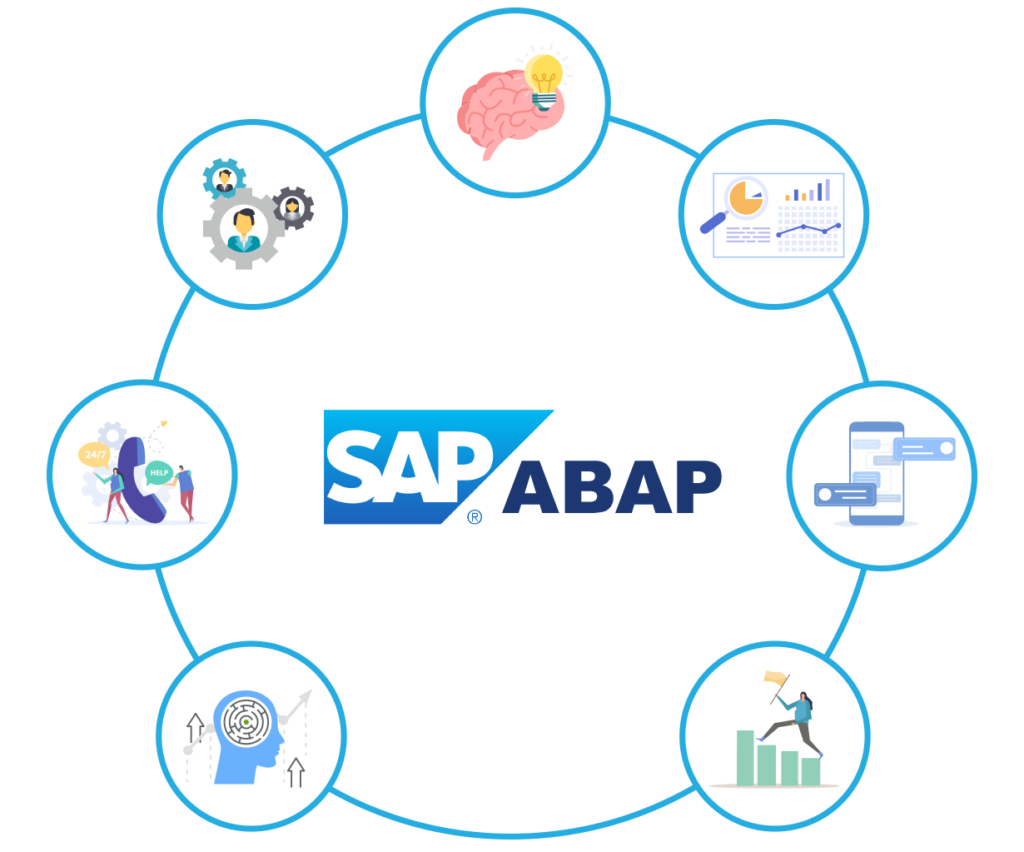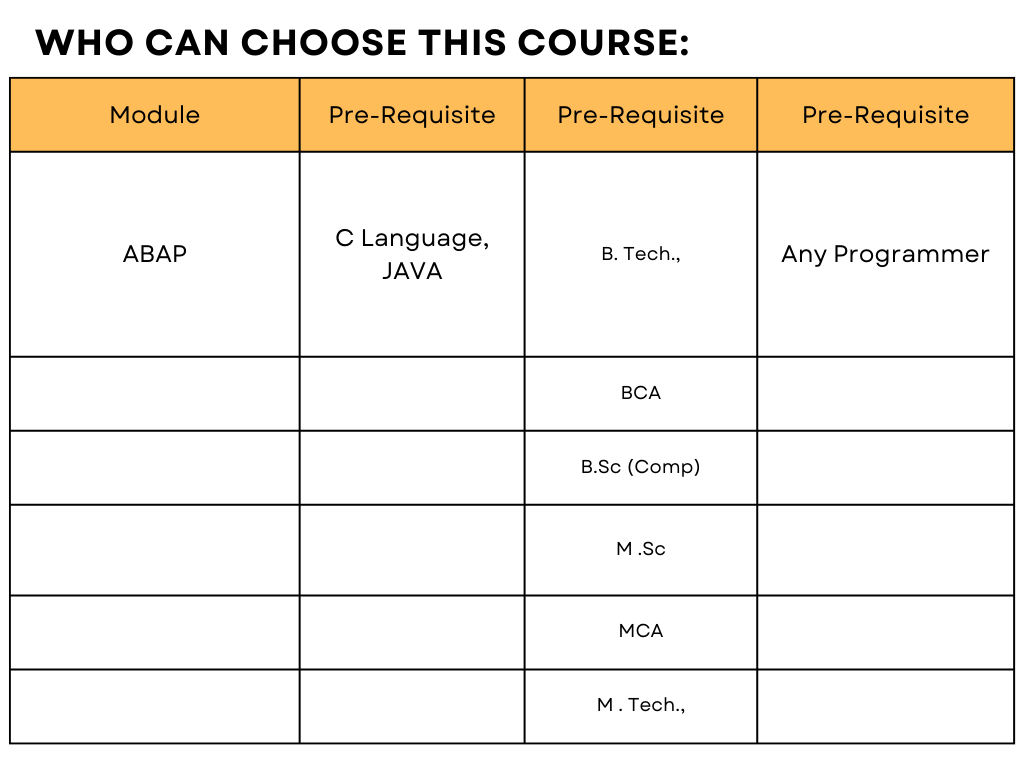SAP – ABAP
SAP ABAP Module is the core Technical Module in SAP. ABAP Module deals with Programming aspect of an SAP Project. An ABAP is basically a Programmer who writes programmer to suit different requirements of Functional Consultants in an SAP Project. An ABAPER must be well versed with Programming Syntaxes and logics related to Programming in order to become a thorough ABAP Programmer. Experienced professionals who are working as Programmers in other than SAP Technologies like JAVA, . Net etc., can learn ABAP and transform into an SAP ABAP Consultant. Candidates who are graduated with B .Tech or M .Tech etc., degrees also can learn ABAP and become an ABAP Consultant.

Eligibility for a course typically depends on the following:
- Prerequisites: Required prior courses or skills.
- Level of Study: Undergraduate, graduate, or continuing education.
- Program Requirements: Specific to your major or program.
- Open Enrollment: Available to all students as an elective.
- Special Permissions: Might need instructor or department approval.
- Availability: Limited seats may give priority to certain students.
- Location/Delivery: Online or specific campus availability.
Check the course catalog or consult with an academic advisor for specifics.

ABAP – COURSE CONTENT
- I) BASIC ABAP
1) Data Dictionary (ABAP Dictionary)
Demo on Table Creation (Pre-defined type)
Demo on Table using Data Element (Using Top-Down Approach
and Bottom-up approach)
Demo on Structures (.include .and .Append)
Demo on Foreign key Relation
Demo on Views
Demo on Variable units and Currencies
Demo on Search Help
Demo on Lock Objects
2) Introduction to ABAP Programming
Demo on Write Statement
Demo on String Functions
Demo on Integer Functions
Demo on Different controls (radio buttons)
Demo on Structures
Demo on Internal tables
Demo on Classical report with Events
Demo on Classical report with Joins
Demo on Classical report using For All Entries
Demo on Radio buttons (using screen fields)
Demo on Radio buttons (using Screen structure)
Demo on Modularization Techniques
Introduction to Interactive Reports
Demo on Interactive reports using Hide method
Demo on Interactive reports using Get Cursor method
Introduction to Function modules
Introduction to ALV (ABAP List Viewer)
Demo on ALV in List Output
Demo on ALV in Grid Output
Demo on Grid ALV by Adding logo, User command, function codes
Demo on Hierarchical ALV
Demo on Interactive Hierarchical ALV Report
Demo on Blocked ALV
3) Module Pool Programming
Introduction to Screen Programming
Demo on Simple screen creation
Demo on Screen-to-Screen Navigation
Demo on Table Control with Wizard
Demo on Table Control Without wizard
Demo on Tab Strip control
Demo on List Box Control
4) Introduction to File handling
Demo on Uploading and Downloading data from the Program/File
Demo on Application server — Dataset
Introduction to BDC(Batch Data Conversion)
Demo on Call Transaction method with TXT File format
Demo on Call Transaction method using .CSV file format
Demo on call transaction method for background execution
Demo on call transaction method using Message handling
Demo on Call Transaction method for Error handling
Demo on Session method
Demo on LSMW(Legacy System Migration Workbench)
5) Introduction to Printing
Introduction to Smart forms
A. Demo on Smart form without driver program
B. Demo on Smart form with driver program
C. Demo on smart forms for adding Customized logo
D. Demo on Smart forms for adding Standard text
E. Demo on smart forms for calculating Sub Totals
Demo on Smart forms for creating Bar Code Creation
Demo on Smart forms for Adding system fields etc.
Demo on Copies Window
6) Introduction to SAP Scripts
Introduction to SAP Scripts
Demo on Scripts using Driver program
Demo on Scripts using Without driver program
Modifying the standard scripts
Converting the SAP Script to PDF Format
Converting the Script to Smart form
II) ADVANCED ABAP
1) Introduction to OOPS
Demo on Local Class
Demo on Converting a local class to Global Class
Demo on Global Class
Demo on Inheritance
Demo on Interfaces
Demo on Polymorphism
Demo on Abstraction
Demo on OOPS ALV(using Container Class)
Demo on OOPS ALV(using CL_SALV_TABLE)
Demo on Constructors
Demo on Exception Class
Demo on Event Handling
2) Introduction to Enhancements
Introduction to Exits
Demo on Field Exit
Demo on Customer exit
Demo on Menu exit
Demo on Screen exit
Overview of User exits
3) Introduction to BADI(Business Add-Ins)
Differences between BADI and Exits
Demo on Custom BADI
Demo on Menu BADI
Demo on Screen BADI
4) Introduction to Enhancement Framework
Demo on Explicit and Implicit Enhancements
Demo on Function module enhancements
Demo on Class Enhancements
5) Introduction to BAPI
Demo on Standard BAPI in SD/MM/FICO modules
Demo on Customized BAPI
Demo on Extension BAPI by adding a custom field in standard
BAPI
6) Overview of BTE (Business Transaction Events)
7) Introduction to ALE & IDOC
Demo on Client to client application transfer
Demo on IDOC to XML Transfer
Demo on IDOC Filtering
Demo on Change Pointers
Demo on IDOC Administration(SARA)
Overview of IDOC Reduction
